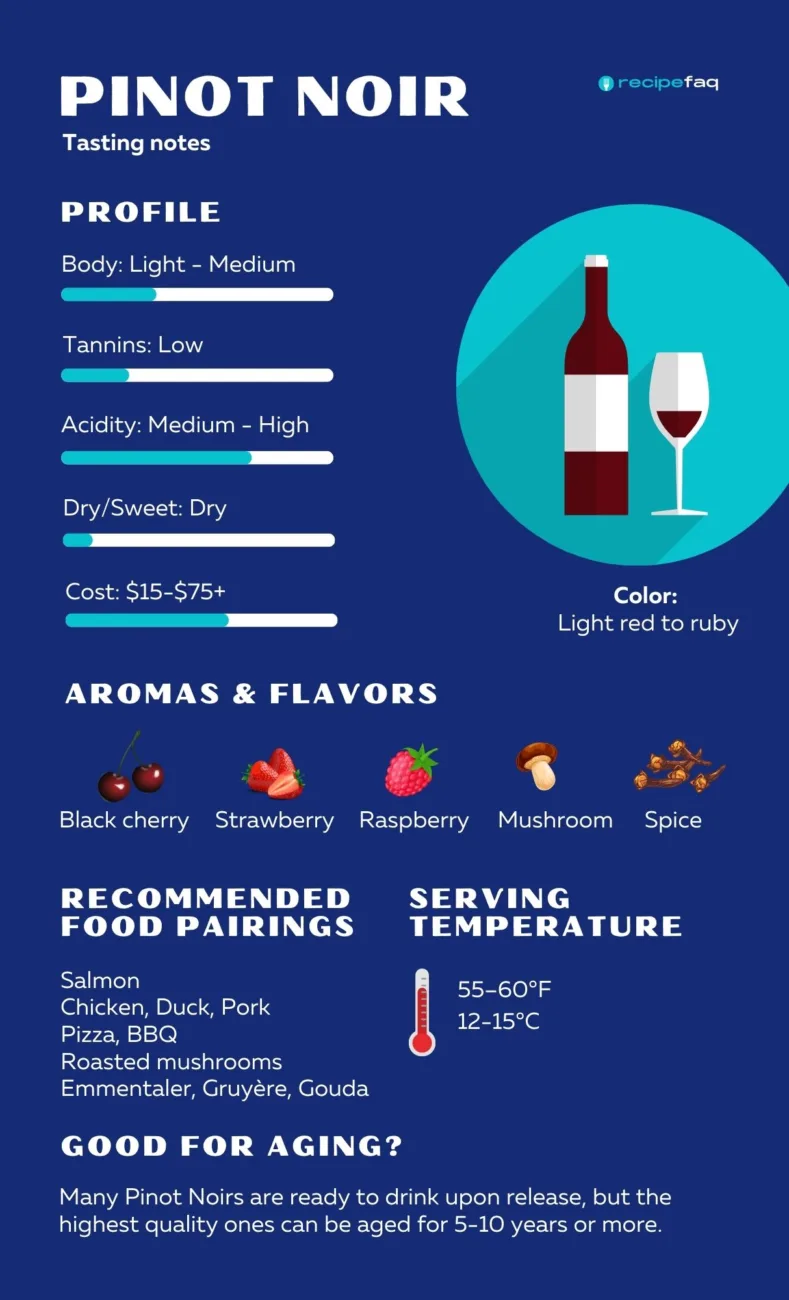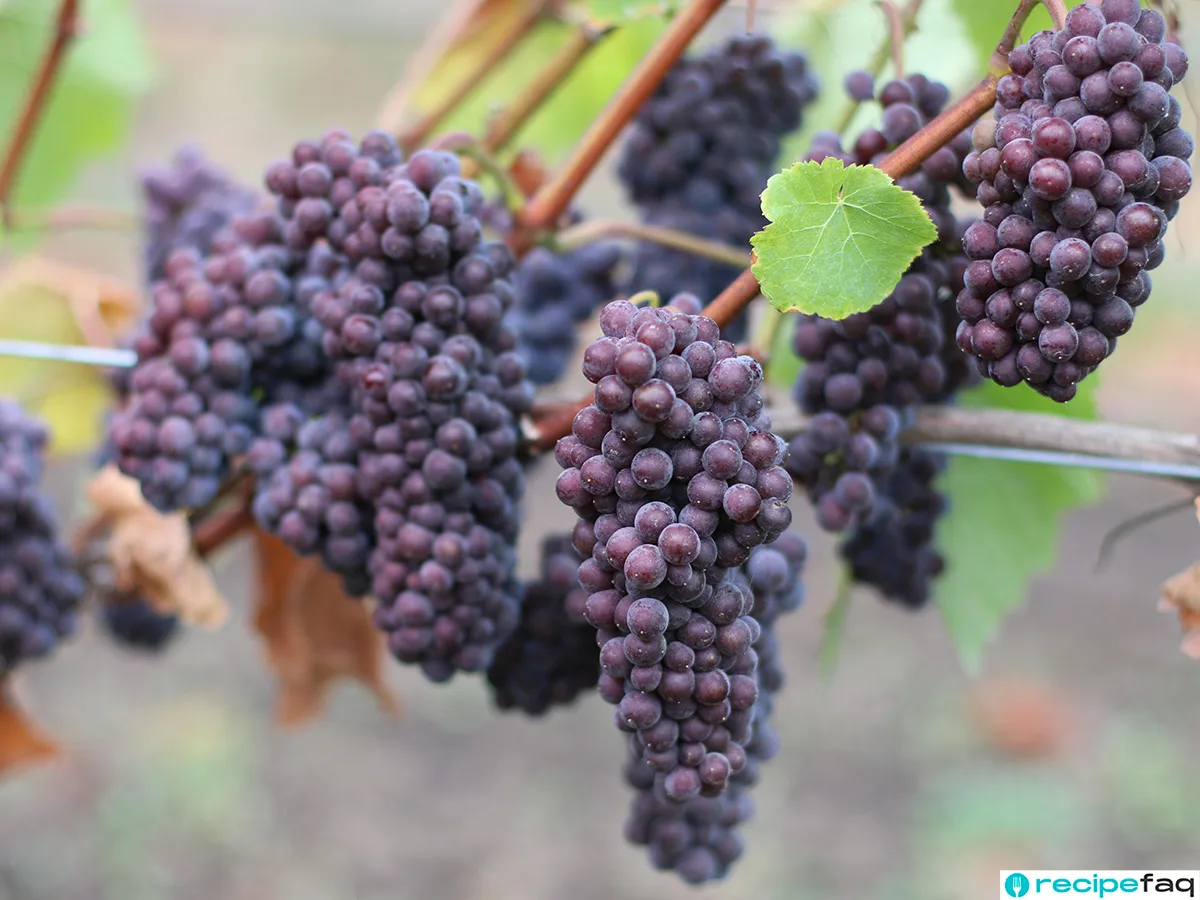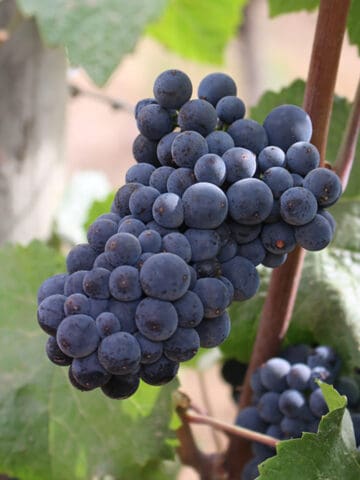These two types of wine are favorites among wine drinkers. And they’re fun to explore if you’re new to wine. But what are the main differences between Pinot Noir vs Cabernet Sauvignon? Here’s a simple-to-follow wine tasting guide.

One is a big bold red. The other is typically more delicate and light-bodied. And both are hugely popular.
With a focus on each wine’s flavor profile, aroma, body style, and ideal food pairings, this simple wine tasting guide will walk you through what makes Cabernet Sauvignon and Pinot Noir unique. And you’ll discover how much you can expect to pay for a good bottle of either.


Jump to:
A brief history of Pinot Noir
Pinot Noir has its roots in France’s Burgundy region. Along with Chardonnay, it’s one of the wine-growing area’s big two grapes.
Dating to earlier than the first century AD, Romans conquering the Gaul region — which later became France — witnessed locals fermenting the Pinot Noir grape and making wine from it. Not ones to miss out on a good opportunity, they quickly adopted the practice. When in Rome, eh? Or in this case, Gaul.
Eventually, Pinot Noir’s popularity grew to become Burgundy’s most widely grown red wine grape.
A prominent characteristic of Pinot Noir grapes is its thin skins. That results in wines with lower tannins and astringency. But it can also leave the grapes more vulnerable to developing rot and disease from hot or cold temperature swings. That makes Burgundy’s cool climates and well-draining, chalky soil ideal for this challenging-to-grow grape.
Apart from still Pinot Noir wine varietals, the grape is also commonly used to produce Champagne and sparkling wine.
Pinot Noir now ranks among the most widely planted grapes in the world. While Burgundy is the largest Pinot Noir growing region, others include the United States (particularly Oregon and California), Australia, New Zealand, Germany, and South Africa.
A brief history of Cabernet Sauvignon
Cabernet Sauvignon is the titan among red wines. Rich in tannins and full-bodied, they’re among the world’s most popular wines.
Like Pinot Noir, the Cabernet Sauvignon grape also hails from France. But its origin is in the Bordeaux region, in the southwest of the country. It’s one of France’s six renowned Bordeaux red wine grapes, along with Merlot, Malbec, Cabernet Franc, Petit Verdot, and Carménère.
The Cabernet Sauvignon grape originated as a cross-pollinated hybrid of Cabernet Franc (a red grape) and Sauvignon Blanc (a white grape) — and it dates back to the 17th century.
From those humble beginnings, Cabernet Sauvignon has grown to far surpass most wine grapes in terms of vineyard acres planted and consumption. Now the grape variety is the most widely grown on the planet.
In addition to France, primary Cab growing regions include the United States (largely California and Washington State), Australia, Italy, South Africa, and parts of South America.
Flavor characteristics and aroma
While both Pinot Noir and Cabernet Sauvignon can have some flavor profile similarities, Pinots are often fruitier and brighter. Here’s a more in-depth breakdown of each.

Pinot Noir
Known for complex, delicate flavors, Pinot Noirs can range from fruit-forward to earthy.
Common flavors include red fruits like strawberry, cherry, raspberry, and currants. Notes of black cherries are also often present, especially in Pinot Noirs produced in Oregon’s Willamette Valley. And thanks in large part to oak barrel aging, these wines will sometimes exhibit flavors of vanilla and baking spices.
One of the more interesting flavor profile descriptions of Pinot Noir is that it can resemble a forest floor. Now if the taste of dried leaves and dirt doesn’t sound appealing to you, don’t worry. It refers more to the types of foods and aromas that you can find there. So think of flavors like mushrooms and earthy aromas you might notice in a forest after a fresh rainfall.
Cabernet Sauvignon
Unlike delicate Pinot Noirs, Cabernet Sauvignon wines are much bolder and grippier. Grippiness in wine refers to a sense of astringency or chewiness, often found in wines with higher tannins.

Tannins are natural substances found in grape skins, stems, and seeds. Grapes like Cabernet Sauvignon have a thick skin, so their tannin levels are higher.
In addition to that grippy feeling on the tongue, they can also add a dryness or chalkiness to wine. And they extend the finish on a wine. So while many Pinot Noirs have a short, light finish, Cabs typically have a longer one that lingers after you take a sip.
While excessive tannins can make a wine feel unpleasantly “chewy,” mellow ones can make a wine smooth and velvety. Good Cabernet Sauvignons exhibit these velvety characteristics. This is often found in ones that have been aged, giving those tannins time to round out and become smoother
Regarding palate, Cabernet Sauvignon wines are full-flavored with notes of darker fruits like blackberry, raspberry, and plum. Common earthy flavor notes include tobacco and leather.
Cabs also exhibit dark fruit in terms of aroma, especially for those grown in warmer European regions. Additional notes of dark chocolate, green bell pepper, green peppercorn, and graphite are not uncommon.
Acidity
Acidity in wine can help make it feel brighter and more lively. Those with high acid coat the sides of your tongue — and you’ll often get some tartness, particularly in white wines.
Temperature plays a big role in why some wine grapes have more acidity than others. Lower temperatures delay ripening and reduce natural sugar levels in the grapes. So wines grown in cooler climates will generally have higher acidity levels. Conversely, ones produced in warmer climates will often have lower acidity.
In red wines, acid can help moderate heavy tannins and alcohol levels.
Pinot Noir
Since a lot of the world’s Pinot Noir grapes are grown in cooler regions, it’s no surprise that they have relatively high levels of acidity.
This often results in bright, vibrant wines. In some cases, they’ll also be noticeably tart. Acidity is especially common in young Pinot Noirs, so it’s commonly recommended to age them for 3-5 years to allow the wine to mellow. Over time, these wines will develop smooth, silky textures.
Cabernet Sauvignon
Depending on the wine region, Cabernet Sauvignon grapes typically range from medium to high acidity. Warm-climate Cabernets, like some grown in California, can be lower in acid than those grown in colder regions like South Africa, for example.
When tasting a Cabernet Sauvignon, look for a good balance of acidity and tannins. Such wines will be enjoyable to consume right away. And they’ll also age well as the tannins even out.
Body
Body is often connected to alcohol content in wine. Grapes higher in sugar content produce more alcohol during fermentation. That helps make the wines feel richer and more full-bodied. Therefore, warmer-region wines tend to seem more structured.
Another factor in body is tannin level. Greater tannins typically mean a wine that feels fuller-bodied compared to those with a lower tannin level.
Pinot Noir
Typically low-tannin Pinot Noirs are often delicate, dry red wines with a light-to-medium body. This can be pleasant in a young wine. But Pinot Noirs can also age exceptionally. After a few years, a young, acidic Pinot Noir can evolve into a complex, velvety wine.
In terms of alcohol level, Pinot Noir averages between 13% and 15%, depending on the climate in which they’re produced.
Cabernet Sauvignon
Cabernet Sauvignon is generally a full-bodied, bold wine with lots of structure. And high tannins contribute to a chewiness and long finish, so it comes across as a substantial, robust wine. Generally, Cabs have medium to high alcohol levels above 13.5% ABV — typically falling in the 14.5% to 15%+ range.
Color
Like its body, colors in Pinot Noir wines can also come across as light and delicate. They can range from a lighter ruby hue to a rich burgundy red. Aged Pinot Noirs or those left in contact longer with the skins during production will typically be darker in color.

Reflecting the black fruits they resemble, deep dark reds are a hallmark of Cabernet Sauvignon color. This is true for both young and aged Cabs. The rich color also contributes to a sense of a fuller body in the wine.
Aging
As we’ve noted, both Pinot Noir and Cabernet Sauvignon wines can age very well.
In many cases, Pinot Noirs are fine to consume soon after release. But if you have the patience, and the right wine, good ones will age superbly in 3-5 years. And very high-quality Pinots can age for up to 20 years.
The high tannin levels found in many Cabernet Sauvignon wines make them excellent candidates for aging. Aging allows the tannins to level off, resulting in a velvety, complex final result.
While some Cab makers produce their wines with the intent for them to be consumed fairly soon after release, many high-quality Cabs are aged for around 2 years in oak barrels before being offered for sale.
After you buy them, they will continue to age nicely for 7 to 10 years. And some of the best ones can age for well over 20 years.
Food pairings
The boldness and flavor profiles of these distinct types of wine mean they will complement different kinds of foods. Here are some food pairing recommendations for each.
Pinot Noir
Pinot Noir wines are fairly versatile when it comes to food pairings. The lighter style often means it will complement lighter dishes, as stronger flavors can overpower the wine.

That said, Pinot Noir will go well with poultry, pork, and pizza. It also complements roast vegetables and mushroom dishes. And the wine’s high acidity can be a nice balance in fattier fish like salmon.
Try it with something like Citrus Herb Chicken, Pork Roast, or Mushroom Gnocchi.
Cabernet Sauvignon
This robust full-bodied wine can be an ideal match for rich cuts of red meat that are higher in fat, like Rib Eye and New York Strip Steak. The meat will help balance the tannins and astringency in the wine. And the pairing will enhance both the flavors of the wine and the steak.
Cabs also go well with rich pasta, short ribs, meatballs, lamb, and earthy vegetables.
Price
Prices for Pinot Noir can vary substantially. Young, ready-to-drink wines can fetch between $15-$20. Better quality Pinot Noirs and ones meant for aging can cost anywhere from $50 to $100.
The cost of a good Cabernet Sauvignon also has a wide range. It’s possible to find one in the $20-$25 range. But high-quality Cabs often sell for $50 or more.
Cabernet Sauvignon vs Pinot Noir summary
Cabernet Sauvignon
- Primary growing regions: France, United States, Australia
- Worldwide growing acres: 840,000
- Body: Full
- Color: Rich, deep red
- Acidity: Medium
- Tannins: High
- Flavor notes: Blackberry, plum, raspberry, green peppercorn, tobacco, leather
- Cost: Tend to be costlier. $30-50+ for a good Cab
Pinot Noir
- Primary growing regions: France, United States, New Zealand
- Worldwide growing acres: 285,000
- Body: Light-medium
- Color: Light ruby hue to dark burgundy
- Acidity: Medium to high
- Tannins: Low
- Flavor notes: Strawberry, black cherry, raspberry, vanilla
- Cost: $15+ for younger Pinot Noir; $30 and up for high quality; $80+ for very high quality
More wine guides
Want to learn more about popular and not-so-common wines? Check out the posts below:






Leave a Reply